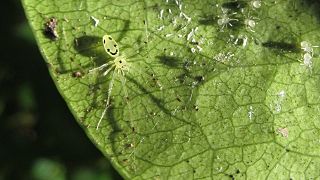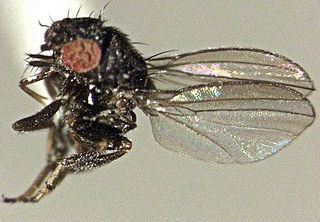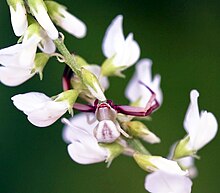
The Thomisidae are a family of spiders, including about 170 genera and over 2,100 species. The common name crab spider is often linked to species in this family, but is also applied loosely to many other families of spiders. Many members of this family are also known as flower spiders or flower crab spiders.

Jumping spiders are a group of spiders that constitute the family Salticidae. As of 2019, this family contained over 600 described genera and over 6,000 described species, making it the largest family of spiders at 13% of all species. Jumping spiders have some of the best vision among arthropods and use it in courtship, hunting, and navigation. Although they normally move unobtrusively and fairly slowly, most species are capable of very agile jumps, notably when hunting, but sometimes in response to sudden threats or crossing long gaps. Both their book lungs and tracheal system are well-developed, and they use both systems. Jumping spiders are generally recognized by their eye pattern. All jumping spiders have four pairs of eyes, with the anterior median pair being particularly large.

Anthocharis cardamines, the orange tip, is a butterfly in the family Pieridae, which contains about 1,100 species. A. cardamines is mainly found throughout Europe and temperate Asia (Palearctic) The males feature wings with a signature orange pigmentation, which is the origin of A. cardamines' common name.

Misumenoides is a genus of spiders in the family Thomisidae. Spiders in this family are commonly called "crab" or "flower" spiders.

Theridion grallator, also known as the Hawaiian happy-face spider, is a spider in the family Theridiidae that resides on the Hawaiian Islands. T. grallator obtains its vernacular name of "Hawaiian happy-face spider" from the unique patterns superimposed on its abdomen, specifically those that resemble a human smiling face. T. grallator is particularly notable because of its wide range of polymorphisms that may be studied to allow a better understanding of evolutionary mechanisms. In addition to the variety of color polymorphisms present, T. grallator demonstrates the interesting quality of diet-induced color change, in which its appearance temporarily changes as it metabolizes various food items.

Misumena vatia is a species of crab spider with a holarctic distribution. In North America, it is called the goldenrod crab spider or flower (crab) spider, as it is commonly found hunting in goldenrod sprays and milkweed plants. They are called crab spiders because of their unique ability to walk sideways as well as forwards and backwards. Both males and females of this species progress through several molts before reaching their adult sizes, though females must molt more to reach their larger size. Females can grow up to 10 mm (0.39 in) while males are quite small, reaching 5 mm (0.20 in) at most. Misumena vatia are usually yellow or white or a pattern of these two colors. They may also present with pale green or pink instead of yellow, again, in a pattern with white. They have the ability to change between these colors based on their surroundings through the molting process. They have a complex visual system, with eight eyes, that they rely on for prey capture and for their color-changing abilities. Sometimes, if Misumena vatia consumes colored prey, the spider itself will take on that color.

Micrommata virescens, common name green huntsman spider, is a species of huntsman spiders belonging to the family Sparassidae.

Gasteracantha fornicata is a species of spiny orb-weavers found in Queensland Australia. It is similar in shape to Austracantha minax which was originally described as Gasteracantha minax. It was described by Johan Christian Fabricius in 1775, the first Australian species of spider to be named and classified.

Milichiidae are a family of flies. Most species are very small and dark. Details of their biology have not yet been properly studied, but they are best known as kleptoparasites of predatory invertebrates, and accordingly are commonly known as freeloader flies or jackal flies. However, because of the conditions under which many species breed out, they also are known as filth flies.

Gasteracantha cancriformis is a species of orb-weaver spider. It is widely distributed in the New World.

Thomisus is a genus of crab spiders with around 150 species described. The genus includes species that vary widely in their ecology, with some that ambush predators that feed on insects visiting flowers. Like several other genera in the family Thomisidae, they are sometimes referred to as flower crab spiders, from their crab-like motion and their way of holding their front legs, reminiscent of a crab spreading its claws as a threat.

Thomisus onustus is a crab spider belonging to the genus Thomisus. These spiders are found across Europe, North Africa, and parts of the Middle East and Asia. T. onustus reside in flowers in lowland vegetation. Females are distinguished by their larger size and ability to change color between white, yellow, and pink as a means of matching flower color. This cryptic mimicry allows them to both evade predators and enhance insect prey capture abilities. Males are smaller, more slender, and drab in coloration, usually green or brown. T. onustus is also distinguished from other relatives by its distinct life cycle patterns in which spiderlings emerge in either late summer or early spring. Furthermore, T. onustus have developed a mutualistic relationship with host plants where spiders feed on and/or deter harmful florivores while benefiting from the plant's supply of pollen and nectar, which T. onustus spiders are able to use as food sources, especially during periods of low insect prey abundance.

Spiders are air-breathing arthropods that have eight legs, chelicerae with fangs generally able to inject venom, and spinnerets that extrude silk. They are the largest order of arachnids and rank seventh in total species diversity among all orders of organisms. Spiders are found worldwide on every continent except for Antarctica, and have become established in nearly every land habitat. As of August 2021, 49,623 spider species in 129 families have been recorded by taxonomists. However, there has been dissension within the scientific community as to how all these families should be classified, as evidenced by the over 20 different classifications that have been proposed since 1900.

Synema globosum is a species of spiders belonging to the family Thomisidae. It is sometimes called the Napoleon spider, because of a supposed resemblance of the markings on the abdomen to a silhouette of Napoleon wearing his iconic hat.

In evolutionary biology, mimicry in plants is where a plant organism evolves to resemble another organism physically or chemically, increasing the mimic's Darwinian fitness. Mimicry in plants has been studied far less than mimicry in animals, with fewer documented cases and peer-reviewed studies. However, it may provide protection against herbivory, or may deceptively encourage mutualists, like pollinators, to provide a service without offering a reward in return.

The genus Oxytate, commonly known as grass crab spiders, comprises a homogenous group of nocturnal crab spiders. The complete mitochondrial genome of the type species O. striatipes was determined in 2014.

Mecaphesa asperata, the northern crab spider, is a species of crab spider in the family Thomisidae, found in North and Central America, and the Caribbean. It is a species of the 'flower spiders', so-called because they generally hunt in similarly coloured flowers for visitors such as bees and flies, and is a much smaller nearctic relative of the better-known Goldenrod Spider.

Mecaphesa celer, known generally as the swift crab spider, is a species of crab spider in the family Thomisidae. Its range is quite large, and it is found throughout much of North and Central America.
Sexual selection is described as natural selection arising through preference by one sex for certain characteristics in individuals of the other sex. Sexual selection is a common concept in animal evolution but, with plants, it is oftentimes overlooked because many plants are hermaphrodites. Flowering plants show many characteristics that are often sexually selected for. For example, flower symmetry, nectar production, floral structure, and inflorescences are just a few of the many secondary sex characteristics acted upon by sexual selection. Sexual dimorphisms and reproductive organs can also be affected by sexual selection in flowering plants.

Thomisus spectabilis, also known as the white crab spider or Australian crab spider, is a small spider found in Australia and far east Asia.























